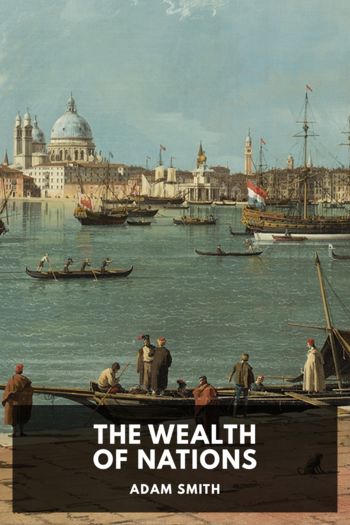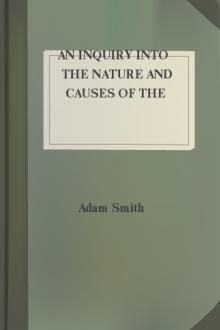The Wealth of Nations, Adam Smith [english novels to improve english .TXT] 📗

- Author: Adam Smith
Book online «The Wealth of Nations, Adam Smith [english novels to improve english .TXT] 📗». Author Adam Smith
Below, here through here. ↩
Above, here. ↩
Below, here. ↩
See Denisart, Article Taux des Intérêts, tom. iii. p. 18. —Smith
J. B. Denisart, Collection de décisions nouvelles et de notions relatives à la jurisprudence actuelle, 7th ed., 1771, s.v. Intérêt, subdivision Taux des Intérêts. This does not go so far as the reduction of 1766. The note appears first in ed. 2. —Cannan ↩
Below, here. ↩
Postlethwayt, Dictionary of Commerce, 2nd ed., 1757, vol. i, p. 877, s.v. Funds, says that the amount of British funds held by foreigners has been estimated by some at one-fifth and by others at one-fourth of the whole debt. But Magens, Universal Merchant (ed. Horsley), 1753, p. 13, thought it “more than probable that foreigners are not concerned in anything like one-fourth.” He had been informed “that most of the money which the Dutch have here is in Bank, East India and South Sea stocks, and that their interest in them might amount to one-third of the whole.” Fairman, Account of the Public Funds, 7th ed., 1824, p. 229, quotes “an account drawn up in the year 1762, showing how much of the several funds transferable at the Bank of England then stood in the names of foreigners,” which is also in Sinclair, History of the Public Revenue, pt. iii, 1790, p. 366. From this it appears that foreigners held £4,627,858 of Bank stock and £10,328,537 in the other funds, which did not include South Sea and East India stock. Fairman had reason to believe that the South Sea holding amounted to £2,500,000 and the East Indian to more than £500,000, which would make in all about £18,000,000. In 1806, he says, the total claiming exemption from income tax (foreigners were exempt) was £18,500,000, but this did not include Bank stock. ↩
Eds. 1–3 read “lands.” ↩
Above, here through here. ↩
Below, pp. here through here. ↩
Below, here through here, and here. ↩
Eds. 1 and 2 read “cheaper.” ↩
Ed. 1 reads “five and forty,” 8 having probably been misread as 5. ↩
Ad Atticum, VI, i, 5, 6. Cicero had arranged that a six-year-old debt should be repaid with interest at the rate of 12 percent per annum, the principal being increased by that amount for each of the six years. This would have very nearly doubled the principal, but Brutus, through his agent, kept asking for 48 percent, which would have multiplied it by more than fifteen. However, Cicero asserted that the 12 percent would have satisfied the cruellest usurers. ↩
Lectures, pp. 130–134. ↩
I.e., the danger of evading the law. ↩
Esprit des lois, liv. xxii, ch. 19, “L’usure augmente dans les pays mahométans à proportion de la sévérité de la défense: le prêteur s’indemnise du péril de la contravention. Dans ces pays d’Orient, la plupart des hommes n’ont rien d’assuré; il n’y a presque point de rapport entre la possession actuelle d’une somme et l’espérance de la ravoir après l’avoir prêtée: l’usure y augmente donc à proportion du péril de l’insolvabilité.” ↩
Joshua Gee, Trade and Navigation of Great Britain Considered, 1729, p. 128, notices the fact of the Dutch being all engaged in trade and ascribes it to the deficiency of valuable land. ↩
See below, here through here. ↩
According to the view of the subject here set forth, if the three employers each spend £100 in wages and materials, and profits are at first 5 percent and then rise to 10 percent, the finished commodity must rise from £331 0s. 3d. to £364 2s., while if, on the other hand, the wages rise from £100 to £105, the commodity will only rise to £347 11s. 3d. It is assumed either that profits mean profits on turnover and not on capital per annum, or else that the employers each have their capital turned over once a year. But even when one or other of these assumptions is granted, it is clear that the “simple interest” may easily be greater than the “compound.” In the examples just given we doubled profits, but only added one-twentieth to wages. If we double wages and leave profits at 5 percent, the commodity should rise from £331 0s. 3d. to £662 0s. 6d. ↩
This paragraph is not in ed. 1; the epigram at the end, however, did not make its appearance here for the first time in ed. 2, since it occurs in a slightly less polished form here. ↩
The general design of this chapter, as well as many of its details, was doubtless suggested by Cantillon, Essai, pt. 1, chaps. vii and viii. The first of these chapters is headed: “Le travail d’un laboureur vaut moins que celui d’un artisan,” and the second: “Les artisans gagnent les uns plus les autres moins selon les cas et les circonstances différentes.” The second ends thus: “Par ces inductions et cent autres qu’on pourrait tirer





Comments (0)